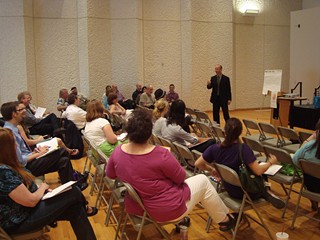Crisis and Opportunity
Do you know your audience?
By Robert Faires, Fri., Aug. 5, 2011
For the second session in its ongoing series Crisis & Opportunity, the Austin Creative Alliance made the shift from a wide-ranging community conversation (see "Crisis & Opportunity: An Open, Structured Dialogue," June 17) to what might have seemed to some to be just a standard workshop on marketing. But while the July 28 presentation by Matt Lehrman, executive director of Arizona's Alliance for Audience and ShowUp.com (an Arizona equivalent to the Austin Creative Alliance's NowPlayingAustin.com listings site), may indeed have had the most value for folks in the performing arts scoping out new strategies to build their audiences, it turned out to be valuable for anyone who cares about the state of creativity in our culture now and how people interact with it. Lehrman developed his seminar and soon-to-be book Audiences Everywhere! in response to Danny Newman's Subscribe Now!, the tome that sold most of the country's arts nonprofits on the idea that subscriptions were the key to their financial security and stability. That book was rightfully influential and still contains much information that's useful, Lehrman maintains, but it also came out the year that the Apple II computer and the space shuttle debuted. He asks whether our culture changed at all since then. If so, it's worth re-examining the way that audiences relate to cultural organizations.
His thesis rests on a division of audiences along x and y axes of interest in a specific organization's work (or the arts in general) and capacity to experience that work (based on time, money, physical ability, etc.). Those with the most interest and capacity – i.e., those who are already patrons and likely faithful ones, too – are the "devoted." Those with interest but less capacity are "oriented;" those with high capacity but little interest are "uninspired;" and those with low interest and low capacity are "asleep." Identifying and understanding the specifics of what engages people and what keeps them from being engaged with the arts will do more to help an artist or arts organization build an audience than catchall strategies like subscription drives or massive ad campaigns.
Condensed from a couple of hours into a single paragraph, Lehrman's ideas may not seem all that revolutionary, but they hit my ear the day after The New York Times ran a review of "Talk to Me," a new exhibition at the Museum of Modern Art in which all the works are rooted in interactivity: QR codes, tweets, touch screens where viewers may actually alter the art on display, and the like. It reinforced for me the sense that people have so many new ways to interact with one another and, in the context of Lehrman's talk, that these are ways Newman could not have imagined back when he was writing Subscribe Now! Increasingly, they are influencing the way folks interact with art. Artists are racing to incorporate social technology into their work, using it to draw audiences more deeply and personally into it – an immediate local example being the Skype theatre piece You Wouldn't Know Her, She Lives in London/You Wouldn't Know Him, He Lives in Texas. It's incumbent upon people who want an audience for their art to give some consideration to the ways they can use technology in the publicity and marketing of creative projects. Certainly, that's already taking place on some fronts – who doesn't whip up a Facebook page for a stage production or art exhibition nowadays? – but if social media is employed as a public relations tool by reflex, it's no more assured of hitting its mark than a generic public service announcement sent to a radio station. Lehrman was challenging those of us at Crisis & Opportunity 2.0 to think about our audiences and expand our modes of interaction with them, whether that's on a technological or personal front. (Volunteerism and parties with artists are still valuable tools.) There's no reason that artists can't be as creative in developing their audiences as they are with their work. Indeed, there's every reason they should be.











